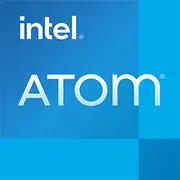Intel Atom E3825

Intel Atom E3825: An Ultra-Budget Processor for Niche Tasks
April 2025
Introduction
The Intel Atom E3825, released in 2014, is a representative of an era when mobile devices were just beginning to struggle for balance between performance and energy efficiency. Eleven years later, this chip still appears in ultra-budget laptops, tablets, and specialized devices. But who finds it relevant in 2025? Let's dive into the details.
Architecture and Process Technology: Minimum at Maximum
Cores, Threads, and Frequencies
The Atom E3825 is built on the Silvermont microarchitecture (codenamed Bay Trail-I) with a 22nm process technology. It is a dual-core processor with no support for hyper-threading (2 cores / 2 threads). The base clock frequency is 1.33 GHz, with no turbo mode. In comparison, modern budget Intel N-series chips (Alder Lake-N) operate on a 7nm process and reach frequencies up to 3.7 GHz.
Integrated Graphics
The built-in GPU is the Intel HD Graphics (Bay Trail) with 4 execution units and a clock speed of 533 MHz. It supports DirectX 11, OpenGL 4.0, and a resolution of up to 2560x1600. However, for gaming or rendering, the capabilities are insufficient: even in 2025, this graphics setup handles only basic tasks like image output or viewing HD videos.
Power Consumption and TDP: Silent Operation Without Fans
The processor's TDP is 6 W, allowing it to operate without active cooling. This is a key advantage for devices where silence is essential:
- Tablets with keyboards
- Digital kiosks
- Media players
However, the low TDP comes at the cost of modest performance. In comparison, the modern AMD Athlon Silver 7120U (TDP of 15 W) offers 2 cores / 4 threads and frequencies up to 3.5 GHz for a similar price.
Performance: Realistic Expectations
Office Tasks
- Browser: 3-5 tabs in Chrome (with heavy scripts disabled).
- Documents: LibreOffice or Google Docs run smoothly, but simultaneous opening of a PDF + spreadsheet + presentation may cause lag.
- Video Calls: Zoom or Skype can operate in SD resolution, but without background filters.
Multimedia
- Video: YouTube at 720p/30fps runs steadily, while 1080p may have stuttering.
- Music and Photos: Listening to tracks and editing images in Paint.NET works without issues.
Gaming
- Older Games: Half-Life 2, Sims 3 at low settings (20-25 FPS).
- Modern titles like Among Us or Stardew Valley can launch but with frequent FPS drops.
Turbo Mode
There is none. The processor runs at a fixed frequency, eliminating short-term "jumps" in performance.
Use Cases: Who is E3825 Suitable For?
1. Education: Affordable laptops for school students (example: Dell Wyse 3040 for $199).
2. Digital Signage: Devices to display advertisements or schedules.
3. Backup Devices: "Just in case" for travel or meetings.
4. Linux Enthusiasts: Lightweight distributions (Lubuntu, Puppy Linux) revive old hardware.
Important! Do not consider E3825 for:
- Video/audio editing.
- Modern OS like Windows 11 (no TPM 2.0 support).
- Multitasking.
Battery Life: Long, But Not Quick
The average runtime of a laptop with the E3825 is 8-10 hours (with a battery capacity of 35-40 Wh). This is achieved through:
- Intel SpeedStep — dynamic frequency reduction during idle times.
- Disabling unused components (Wi-Fi, Bluetooth).
However, the battery life of modern chips (like the Apple M1 in MacBook Air) is higher for similar tasks—up to 18 hours, but they start at $999.
Comparison with Competitors: Who Else is in the Same Class?
1. AMD A4-9120e (2019): 2 cores/2 threads, TDP 6 W, clock speed up to 2.4 GHz. Better in multitasking (+15% performance), but rarely found in new devices.
2. Intel Celeron N4020 (2020): 2 cores/2 threads, TDP 6 W, clock speed up to 2.8 GHz. Supports DDR4 and Wi-Fi 6, making it preferable for budget laptops in 2025 (e.g., Acer Aspire 1 for $249).
3. ARM Processors: For example, the MediaTek MT8183 in Chromebooks. Better optimization for web applications but limited compatibility with Windows software.
Pros and Cons: Is it Worth It?
Strong Points
- Price: Devices with the E3825 range from $150 to $250.
- Passive Cooling: No noise.
- Compactness: Suitable for mini-PCs and thin laptops.
Weak Points
- Outdated Architecture: No support for AVX or modern instructions.
- Limited OS: Windows 10 32-bit or Linux.
- Small RAM Capacity: Typically 2-4 GB, which is critical for browsers in 2025.
Recommendations for Choosing a Laptop
If you decide to buy a device with the E3825, pay attention to:
1. Type of Storage: SSD is preferable over eMMC (example: Lenovo Ideapad Slim 110 with 64 GB SSD).
2. Screen: An IPS matrix with a resolution of 1366x768 is the minimum for comfort.
3. Ports: At least one USB 3.0 for external drives.
4. Operating System: Linux distributions like Zorin OS Lite will reduce system load.
Advice: For $300, you can find a laptop with an Intel Celeron N4500—it will support Windows 11 and be 40% more powerful.
Final Conclusion: Who is E3825 For?
This processor is for those who need:
- An inexpensive device for basic tasks.
- A specialized device with long battery life.
- A backup laptop without demands for power.
In 2025, the E3825 is an anachronism, but it is still justifiably used in niches where price matters more than speed. However, if your budget allows for an additional $50-100, it’s better to choose something from the Intel Celeron N-series or AMD Athlon Silver segment—you will gain a noticeably more modern and flexible tool.
Basic
CPU Specifications
Memory Specifications
GPU Specifications
Benchmarks
Compared to Other CPU
Share in social media
Or Link To Us
<a href="https://cputronic.com/en/cpu/intel-atom-e3825" target="_blank">Intel Atom E3825</a>